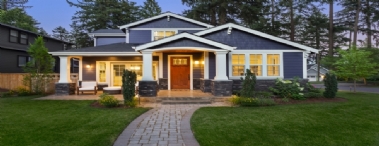
In many cities across North America traditional forms of landscaping have not only gone out of fashion, they are often against municipal bylaws. Pesticides have been banned in many areas and watering limitations no longer allow homeowners to set the sprinkler out and forget about it. Sustainable landscaping is the best way to maintain a healthy attractive lawn and garden. Tips on how to design and work with this type of landscape are surprisingly straightforward.
Lawns That Need Less Water
In order to ensure your lawn can survive and thrive during a watering ban it is important that you plan well. Seed your lawn with grasses that are well suited for your climate.
Cool season grasses grow best in areas where a cold, frigid winter turns into a dry, hot summer. Homes in the Canadian prairies are a prime example of these conditions, as are many northern suburbs. Kentucky bluegrass and tall fescue are two commonly used cool season grasses that can handle both cold and hot conditions, as well as dry spells.
Warm season grasses grow best in locations where the winters are milder, but the summers can get unbearably humid or incredibly dry. Zoysia grass is perhaps the most common, with Buffalo grass following closely behind. If you have planted grass that is well suited to your climate it will become well established, require less water and thrive even in extreme conditions.
Smaller lawns require less water so cutting back on the amount of grass is a wise option. Most suburban lots can be mowed with a push mower, which will also reduce the amount of pollutants produced while maintaining a well-manicured lawn.
The general rule is that your lawn needs one inch of water per week. If the rain will provide an adequate amount of moisture there is no need to supplement with your hose.
Greener Gardens
A sustainable landscape means green gardens as well, including low care perennials that will provide an attractive view from inside your home, as well as from the curb. Again it is best to go with native plants and trees in your garden design. These species have been growing in your area for generations and are well adapted to the soil conditions and pests commonly found there.
Drought tolerant plants are also a good idea, unless you live in a moist climate such as the coastal regions. Often more tropical varieties are best for these gardens. Search out a list of native plants, shrubs and trees for your zone and geographic area. You can mix in other plants as well, but be sure you are well aware of the care required. It's also a good idea to mulch your gardens heavily. This will not only cut back on weeding, but acts as an excellent barrier against the heat of the sun.
Try not to choose invasive species, unless your plan is to have them cover the entire area. Invasive plants and shrubs are hearty and will often require little care, but they will also take over all of the other plants in the area, including grass and larger, more mature trees. This can result in an unattractive garden and requires a large amount of work to remedy once those invasive species have rooted themselves.
Pests and Problems Can Be Dealt With Sustainably
Although the main idea of a sustainable landscape is to make it low maintenance, you will undoubtedly run into some issues along the way. Pests and disease are common in nature and even native plants can take a hard hit when a particular fungus or bug has invaded the neighborhood.
Plan ahead for these problems and design your garden for natural pest resistance. Use companion planting to deter certain bugs from attacking their favorite plants. This works well for tiny insects and larger pests like rabbits and deer, although they might not be as much of a problem in the suburbs. Companion plant pairings will be different for every zone. Native plants are best in this situation as well, but using a non-native species in this useful fashion is certainly a sustainable idea.
Hardscaping Helps
Including hardscaping features in your landscape plan is essential for many different reasons. Hardscape features (things like stone patios, retaining walls, decks and fences) add visual interest and serve practical purposes. They also require very little maintenance and when built in natural materials they are sustainable on their own.
But these hardscaping features also help to maintain a balance in your yard. They make the space more usable and cut down on the grass and greenery that require watering. Opt for a quality design and professional installation to ensure that your hardscaping will last. Having to rebuild or repair due to faulty construction and poor materials is not a sustainable choice.
Fertilize the Smart Way
There are plenty of ways to fertilize that do not involve dangerous herbicides. Compost (in solid form and as compost tea) is an extremely easy and effective way to fertilize the grass or the garden. Sprinkle a light layer of compost onto your grass to help it grow lush and full. Composted manure can be a good choice, as well as composted kitchen scraps and garden waste. Be sure to avoid putting diseased or pest infested greenery in your composter, as this will spread more problems across your lawn.
Compost works well on your garden as well. Make a batch of compost tea for your potted plants and all of your plants will be well looked after. With this type of natural fertilizer you can not only look forward to a healthy landscape, but you'll also be cutting back on garbage by composting organics.
You don't need to depend on pesticides, herbicides and an extensive sprinkler system to enjoy an attractive landscape. With these sustainable landscaping tips you can look forward to a beautiful lawn and garden that requires very little maintenance. Plant the right kinds of grass, trees and flowers, use hardscaping wisely to create balance and remember to fight pests and fertilize the natural way. This is how sustainable landscaping is done and it's easier than you think.
Posted by: TrustedPros





